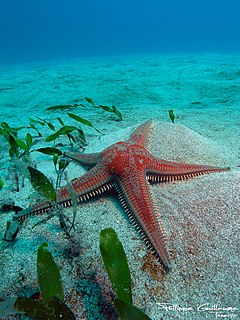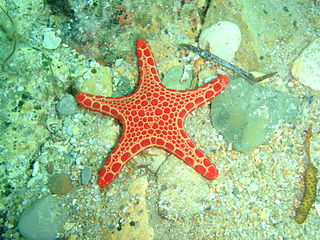
Sea cucumbers are echinoderms from the class Holothuroidea. They are marine animals with a leathery skin and an elongated body containing a single, branched gonad. Sea cucumbers are found on the sea floor worldwide. The number of holothurian species worldwide is about 1,717 with the greatest number being in the Asia Pacific region. Many of these are gathered for human consumption and some species are cultivated in aquaculture systems. The harvested product is variously referred to as trepang, namako, bêche-de-mer or balate. Sea cucumbers serve a useful role in the marine ecosystem as they help recycle nutrients, breaking down detritus and other organic matter after which bacteria can continue the degradation process.

Apodida is an order of littoral to deep-sea, largely infaunal holothurians. This order comprises three families, 32 genera and about 270 known species, called apodids.

The Astropectinidae are a family of sea stars in the order Paxillosida. Usually, these starfish live on the seabed and immerse themselves in soft sediment such as sand and mud.

Scotoplanes, commonly known as the sea pig, is a genus of deep-sea sea cucumbers of the family Elpidiidae, order Elasipodida.

Goniasteridae constitute the largest family of sea stars, included in the order Valvatida. They are mostly deep-dwelling species, but the family also include several colorful shallow tropical species.

Hippasteria phrygiana is a sea star species, member of the Goniasteridae family.

Enypniastes is a genus of deep-sea sea cucumber. Due to its unique appearance, the genus has been dubbed the headless chicken fish, headless chicken monster, and the Spanish dancer. It is also known as the swimming sea cucumber, and some are called the pink see-through fantasia.

Elasipodida is an order of sea cucumbers. They have numerous appendages, including conical papillae and leaf-like tentacles. Although many species are benthic, a number are pelagic, and may have their appendages modified to form sails or fins. Most members of the order inhabit deep-sea environments, like Enypniastes.

Cidaridae is a family of sea urchins in the order Cidaroida.
The star pearlfish, Carapus mourlani, is a species of slender, ray-finned fish in the family Carapidae. It normally lives inside a starfish or a sea cucumber.

Hippasteria is one of 70 genera of sea star in the diverse family Goniasteridae.
Trophodiscus is a genus of starfish in the family Astropectinidae. There are only two species, both found in fairly deep waters in the Sea of Okhotsk. Trophodiscus almus is also found in the Sea of Japan and around the Japanese island of Hokkaido. These starfish are very unusual in that the young are brooded on the upper surface of the female.

The Echinothuriidae are a family of sea urchins in the order Echinothurioida. Due to their soft skeletons, most are called "leather urchins", but species in the genus Asthenosoma are also known as "fire urchins" due to their bright colors and painful, venomous sting.

Pelagothuria natatrix is a species of sea cucumber, in the family Pelagothuriidae.

Evoplosoma is a genus of deep-sea sea star in the family Goniasteridae.

Myriotrochidae is a family of sea cucumbers.

Hippasteria muscipula is one of twelve species of deep-sea sea star in the genus Hippasteria, which is in the family Goniasteridae.
Paulasterias mcclaini is a species of starfish in the family Paulasteriidae. It is found in deep water at hydrothermal vents.

Molpadia musculus is a species of sea cucumber in the family Molpadiidae. It is found in deep waters in the Atlantic Ocean, burrowing in the mud.

Psychropotidae is a family of deep-sea swimming sea cucumbers. The geographic range of some psychropotids is very extensive at abyssal depths, whereas other species are found within more restricted ranges.
















